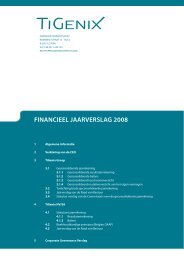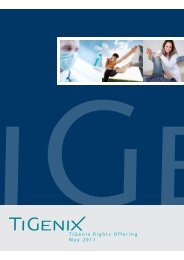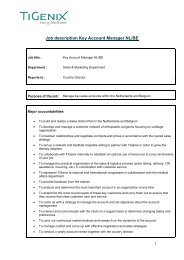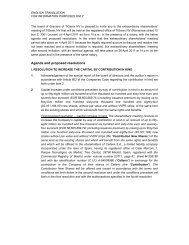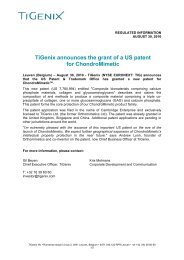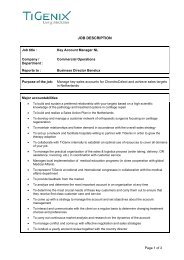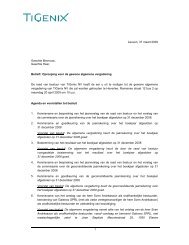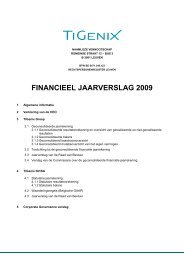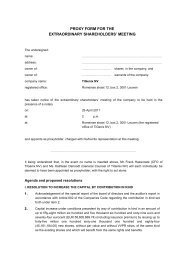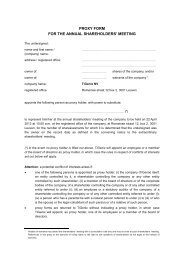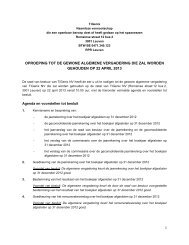ANNUAL REPORT 2012 - TiGenix
ANNUAL REPORT 2012 - TiGenix
ANNUAL REPORT 2012 - TiGenix
You also want an ePaper? Increase the reach of your titles
YUMPU automatically turns print PDFs into web optimized ePapers that Google loves.
Therapeutics (product Hyalograft C) and<br />
Cellmatrix in Scandinavia. Next to these<br />
companies, there are a number of hospitals<br />
that produce autologous cartilage for their<br />
own patients.<br />
6.5. PRODUCTS IN DEVELOPMENT :<br />
THE ADIPOSE DERIVED<br />
STEM CELL PLATFORM<br />
6.5.1. Products and technology<br />
Cell-free products<br />
Alternative competition may come from cellfree<br />
products that also target the cartilage<br />
repair market, but that will generally be<br />
brought to market through the medical<br />
device regulatory route. Several ACI<br />
companies such as BioTissue are considering<br />
abandoning the cell-based products, and<br />
are attempting to bring one-step, cell-free<br />
products to the market through the CE<br />
marking route in Europe. Examples of other<br />
competing products are AMIC (Geistlich), a<br />
collagen membrane used in combination<br />
with microfracture and BST-Cargel<br />
(Piramal) and GelrinC (Regentis) self-gelling<br />
products, also for use in combination with<br />
microfracture. Gelrin C is currently not for<br />
sale in Europe and US, but is expected to<br />
apply for CE mark in 2013 13 .<br />
For the treatment of osteochondral defects<br />
there are several solutions in the market.<br />
Kensey Nash is currently involved in a Phase<br />
II trial for an acellular osteochondral graft.<br />
The same company also markets Osseofit, an<br />
osteochondral scaffold. Similar scaffolds are<br />
offered by Smith & Nephew (TruFit), and Fin<br />
Ceramica (MaioRegen).<br />
<strong>TiGenix</strong>’s strategy is to exploit the recognized<br />
mechanism of action of expanded<br />
adipose-derived stem cells (“eASC”) in<br />
immune-mediated inflammatory processes<br />
and to develop groundbreaking allogeneic<br />
stem cell products for treating a broad range<br />
of inflammatory and autoimmune diseases.<br />
The Company’s current development<br />
programs are based on a proprietary<br />
technology platform of eASCs. The rationale<br />
for choosing eASCs as a highly competitive<br />
and next generation platform for future<br />
market opportunities in inflammatory and<br />
autoimmune diseases is outlined here below.<br />
Mechanism of action<br />
Two main biological mechanisms underlie<br />
the efficacy of stem cells in disease<br />
treatment : their anti-inflammatory<br />
properties, and their secretion of repair<br />
and growth promoting molecules. For the<br />
treatment of inflammatory and autoimmune<br />
diseases, the former property is thought to<br />
play the most fundamental role.<br />
Certain stem cell populations act as<br />
immunomodulatory agents by interacting<br />
with cells of the immune system. <strong>TiGenix</strong>’s<br />
scientists have been able to confirm that<br />
activation of eASCs by interferon-gamma<br />
(“IFN- ”) 14 , and the subsequent expression<br />
of tryptophan metabolizing enzyme<br />
Indoleamine 2,3 dioxygenase (“IDO”) 15<br />
11<br />
http ://clinicaltrials.gov/ct2/show/NCT01656902?term=novocart+3d&rank=1<br />
12<br />
http ://clinicaltrials.gov/ct2/show/NCT01222559?term=chondrosphere&rank=2<br />
13<br />
http ://medtechinsider.com/archives/28003<br />
14<br />
Best Pract Res Clin Haematol. 2011 Mar;24(1) :49-57. Epub 2011 Feb 23. “Mesenchymal stem cells and autoimmune diseases.”<br />
15<br />
Stem Cells Dev. 2008 Aug;17(4) :681-93.”Soluble factors-mediated immunomodulatory effects of canine adipose tissue-derived<br />
mesenchymal stem cells.” Kang JW, Kang KS, Koo HC, Park JR, Choi EW, Park YH.<br />
59



